Ah, Summertime, and the livin’ is easy! Iced tea and flip-flops. The sun riding high in the sky. Burgers are on the grill, and it’s time to eat produce that remembers where it came from. Picture it…pea pods straight off the vine, tomatoes warm from the sun, crisp lettuce, crunchy carrots.
If you buy a share in a CSA farm, you won’t need to imagine. You’ll be savoring the very best your neighborhood farm has to offer, and you’ll get to meet the folks who actually grew your food. Before you know it, you might even be talking companion planting, beneficial insects, and composting, just like a pro!
CSA is an acronym for Community Supported Agriculture, also sometimes known as Community Shared Agriculture. The concept is simple. Community members provide working capital to a farmer in the spring by buying, in advance and sight unseen, a share of what their local farmer will produce over the growing season.
During the fallow months of winter, a farm may not generate much or any income. But, come springtime, with the capital provided upfront by CSA members, a farmer can still afford to purchase supplies and seeds, pay employees, and cover other early-season operating costs. Also, since farmers are selling direct to consumers, they don’t have to commit as much time and money to marketing their crops, but they’ll still receive good prices for them from their guaranteed clientele.

But what’s in it for members? Quite a lot as it turns out. Buy a share in a CSA and you’ll enjoy the health benefits of a regular supply of fresh food, plus the opportunity to learn from the grower or other members how best to prepare it. You’ll have the security of seeing exactly how and where your food was grown, ensuring that you won’t be feeding harmful pesticides to your loved ones. And you’ll reap the emotional benefits of being more connected to the earth and its seasons, too. Buying locally produced food even allows you to reduce your contribution to global warming: local produce doesn’t have to travel long distances to you in carbon-emitting vehicles.
Sounds great, doesn’t it? So what’s the downside? Risk. Traditionally, a farmer bears the financial brunt if, say, a rainy summer rots the corn on the stalk, a drought withers the salad greens, or worms kill all the tomato plants. A CSA spreads that risk among farmer and members. If there is a poor growing season, then members get less bang for their buck. On the other hand, the farmer won’t be wiped out financially and forced to go out of business. Instead, he or she will be around to recoup those losses and feed the community the following year.
Are there other disadvantages? Well, since supermarkets have accustomed us to buying pretty much any kind of food we want, any time we want it, buying produce only when it’s in season can take some getting used to. Also, it might be a little disconcerting at the beginning of the growing season, when not much produce has been, well, produced, and you show up to pick up your weekly share only to wonder, like Peggy Lee, “Is that all there is?” Of course, this is balanced out by the middle of the growing season, when your CSA box will be overflowing with bounty. And towards the end of the growing season in the fall, you’ll be getting a pretty good workout when you have to cart home a hefty box of potatoes and squash.
You shouldn’t expect to obtain all the produce you need from a CSA farm; you might want to supplement your CSA visits with trips to the grocery store for the more exotic (or out-of-season) items you crave. LocalHarvest, an organic and local food web site, cautions that if your family is large and you cook often, you might need to buy additional quantities of basics like onions, garlic, and carrots from another source, even if you already get these from your CSA. The web site also advises potential CSA members to ask whether the CSA they are considering provides fruit, and if so, how much of it, noting that at many CSAs fruit is not available.
So, now that you know some of the pros and cons of CSAs, here are a few tips to bear in mind before you take the plunge:

LocalHarvest recommends you ask your CSA farmers questions! Ask about their experience with farming and with CSAs. Ask how many members participate. Find out what type of produce to expect, how much of it to expect, and when to expect it–salad greens and peas, for instance, arrive near the start of the season, while tomatoes won’t be ripe until around August. Also, if you are considering canning or preserving, ask your CSA farmers early in the season if they allow members extra quantities of the fruits or vegetables you’re interested in laying by. Check whether the produce is organic (grown without synthetic pesticides and chemical fertilizers). Ask, too, how much of the produce comes directly from the CSA and how much, if any, is from other sources. Familiarize yourself with the CSA’s policies regarding issues such as what happens to your produce if you are unable (or forget) to pick it up. Finally, talk to members of the CSA before you commit yourself, so that you can learn about their experiences, positive and negative.
Visiting your CSA on pick-up days can be great way to meet and mingle with your neighbors and swap recipes and cooking techniques. They’re fun and welcoming places to bring your kids, and they provide a natural, low-key opportunity to teach youngsters about nutrition and healthy eating habits. Plus, you get to walk on the wild side, eating vegetables you may not have tried before, or even heard of, but which may end up becoming a family favorite. Also, remember, if you don’t have the capital to invest upfront in a CSA share, or your local CSAs have sold all their shares (CSAs can have anywhere from a couple of dozen members to hundreds) try shopping for fresh produce at your local farmers market, since some CSAs also operate stalls at them. Or find out whether your local CSA also sells vegetables the old-fashioned way, from a farm stand. Lastly, consider a CSA for more than just vegetables or fruit. Some CSAs offer meat, poultry, eggs, and dairy products, herbs, fresh flowers, and preserves. Some partner with other farms to sell products they don’t produce on site. Again, you’ll want to do your homework and find out just how these offsite items are grown.
Community Involved in Sustaining Agriculture (CISA) offers a list of local CSAs on their web site, sorted by region, items sold, and even whether or not they offer home delivery.

